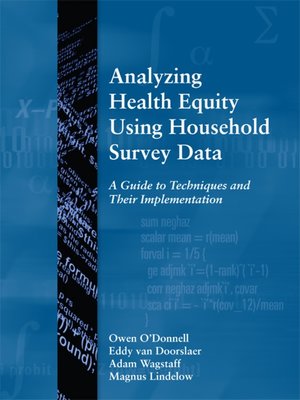Analyzing Health Equity Using Household Survey Data
ebook ∣ A Guide to Techniques and their Implementation · WBI Learning Resources
By Adam Wagstaff

Sign up to save your library
With an OverDrive account, you can save your favorite libraries for at-a-glance information about availability. Find out more about OverDrive accounts.
Find this title in Libby, the library reading app by OverDrive.



Search for a digital library with this title
Title found at these libraries:
| Library Name | Distance |
|---|---|
| Loading... |
Have gaps in health outcomes between the poor and better off grown? Are they larger in one country than another? Are health sector subsidies more equally distributed in some countries than others? Are health care payments more progressive in one health care financing system than another? What are catastrophic payments and how can they be measured? How far do health care payments impoverish households? Answering questions such as these requires quantitative analysis. This in turn depends on a clear understanding of how to measure key variables in the analysis, such as health outcomes, health expenditures, need, and living standards. It also requires set quantitative methods for measuring inequality and inequity, progressivity, catastrophic expenditures, poverty impact, and so on. This book provides an overview of the key issues that arise in the measurement of health variables and living standards, outlines and explains essential tools and methods for distributional analysis, and, using worked examples, shows how these tools and methods can be applied in the health sector. The book seeks to provide the reader with both a solid grasp of the principles underpinning distributional analysis, while at the same time offering hands-on guidance on how to move from principles to practice.







